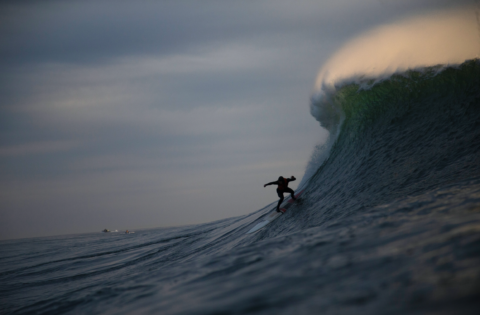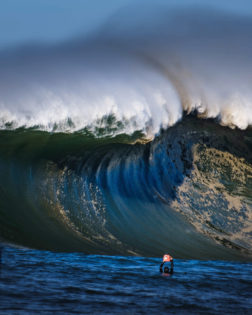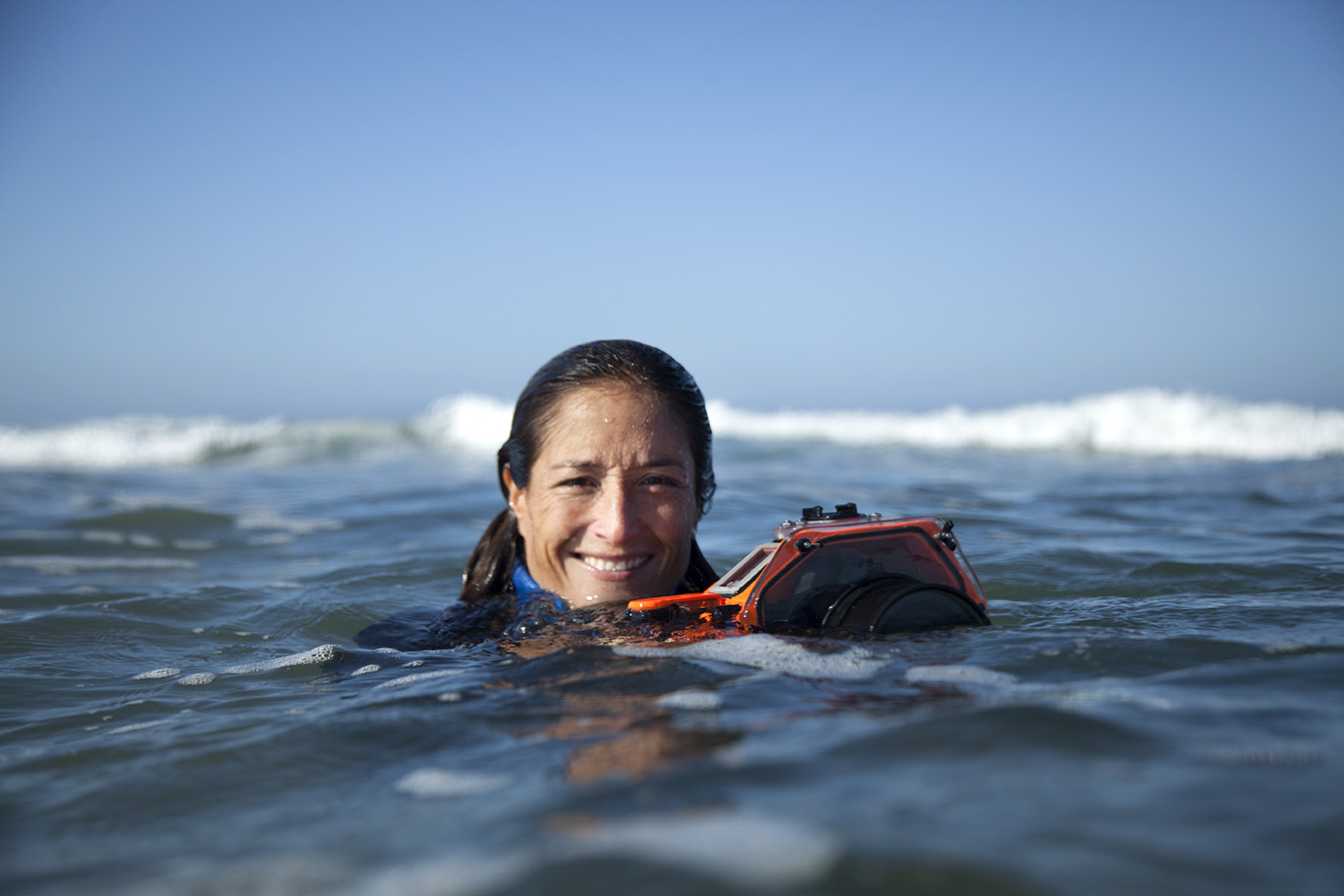THE BEAUTIFUL SURRENDER
This past Christmas my eight-year-old daughter figured out that Santa Claus wasn’t real. “Is Santa Claus really just everyone’s parents?” she asked, suspicious after a school friend boysplained. Somehow though, she remains convinced that mermaids are real.
After a flurry of recent googling she posted notes onto her bedroom bulletin board: “Are mermaids real?” one card asks. Another card answers: “Yes, they have to be.” Another card features a sketch of the world with an arrow pointing to Australia. A detailed drawing of Mako Island follows – she’s a devoted Mako Mermaids fan. Another card declares: “My goal is to take a picture of a mermaid.”
I do not hail from Australia, but I like to fancy myself a mermaid when I swim with my camera. I’m most fond of swimming in the large waves of Ocean Beach (aka OB) across the street from my home in San Francisco, California, and at Mavericks, our local aquatic version of Mount Everest.
The Pulitzer winning author William Finnegan describes OB in his book Barbarian Days as “impossible, like trying to swim up a waterfall” and “as complicated a proposition as any surf spot I’ve seen. Had it been a book, it would have been something dauntingly difficult – continental philosophy, theoretical physics.” The water that comes in and out of the Bay under the Golden Gate Bridge acts like a rivermouth for this three-mile beach break at the edge of the Pacific. Drownings are common due to strong currents and rapidly changing conditions.

Learning to swim with your camera at OB and Mavericks requires a comfort with distorted reality and magical thinking not unlike what is required to believe mermaids are real. When a thirty-foot wall of whitewater approaches, it does not help to consider that moment in practical terms. The only thing that matters is confidence in your ability to survive. Like a mermaid of course.
The irony of shooting photos in the surf is that most of the time my eyes are closed. If I’m in a clear, warm water spot I keep my eyes open in order to weave through the reef, or sometimes sneak under it. But I stopped opening them underwater here long ago. It helps to save my eyes from saltwater damage and preserves the energy it takes to see, which is futile amidst the various shades of black and dark green. Instead, I meditate on staying calm and finding my mermaid flow.
I use my hands sometimes to grip the sand at the bottom, listening for the muted yet frighteningly close boom of the wave above me to pass, feeling my way through the depths, around the turbulent columns of water that ruthlessly ragdoll you if you edge too close, or pull you down like quicksand if you come up too early. Just as a surfer navigates the ribs and crevices of an oversized wave face with their gun, I find my groove while blindly weaving my way through these columns of angry water. I’m actually quite afraid of heights, so perhaps it makes sense that I find solace on and below the surface.
You have to have a certain fight in you to surf or swim at OB. Swimming out to the far bar on a big day feels something like trying to destroy a punching bag at the gym. As a cancer survivor with a bipolar 1 diagnosis that I have tried to manage for over 25 years, this fight comes naturally and is mutually beneficial to the other fights in my life. Part of the reason I shoot in the water is to keep this fight strong on land, where it is actually much harder to stay sane and survive. Shooting in giant waves makes me feel much stronger than my 5’2” Asian female frame. Micro aggressions from land life disappear when I put on my mermaid tail and the storm in my head feels at equilibrium in the relentless pounding of large waves.
I try to mirror the surfer I’m following in order to become the yin to their yang, swimming up the wave’s face as they surf down. However, with big-wave water photography no matter the spot, there is an element of surrender that I think differs from surfing the wave. While I’m constantly kicking and checking my land lineups in order to be in the best position for the wave without endangering myself or the surfer, one can never underestimate the inevitable sneaker sets. Having suffered the wrath of this power in my early days of shooting, I’ve learned that it’s not worth expending the energy in a futile effort of escape. Instead, you simply surrender. The “fight” instead becomes how to frame your shot while constantly calculating how long you can stay on the surface before diving to the safety below. The joy and thrill is being able to absorb some of that wave energy as it passes through you rather than float above it.
Many surfers here build up their big-wave chops by training on the biggest days at OB before giving Mavericks a go. It was the next logical step for me to try to also try to swim and shoot at Mavericks eight seasons ago. I was inspired by a gathering of twelve big-wave women who had convened for an unofficial competition. The difference between Mavericks and Ocean Beach is that there is a channel that you can mostly depend on. The current can sometimes push you away from harm’s way, or you can spend your entire session swimming against what feels like the edge of a waterfall constantly pulling you in.
Eight seasons into this big-wave game, I feel like I’m only at the starting line. At 48 years young I just hope I can maintain the physical health to keep giving it a go when the conditions present themselves. We’ve been blessed with the best run of swell I’ve seen in my 20 years in Northern California, which coincided with a sabbatical from my job teaching journalism at San Francisco State University. I missed some of the action while juggling homeschooling duties but given the reality of most people during this time, I’m well aware of my good fortune.
“Show, don’t tell” is something I drill into my students, so here are a few of my images from this past winter. Perhaps someday my daughter will accept these pages as the next best thing to that photo she is determined to snap when we finally make it to the shores of my mermaid kin in Oz.

